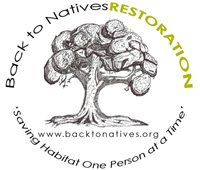 Back to Natives Restoration (BTN) has had a great start on our
Habitat Restoration Service Learning program, this year. The program, funded by REI, Wells Fargo, the
Orange County Community Foundation, Ralphs and a Project Learning Tree
GreenWorks! Grant, has brought 181 students to Santiago Park Nature Reserve, a
23 acre reserve in Santa Ana, CA, bisected by over 5000 feet of Santiago Creek.
Back to Natives Restoration (BTN) has had a great start on our
Habitat Restoration Service Learning program, this year. The program, funded by REI, Wells Fargo, the
Orange County Community Foundation, Ralphs and a Project Learning Tree
GreenWorks! Grant, has brought 181 students to Santiago Park Nature Reserve, a
23 acre reserve in Santa Ana, CA, bisected by over 5000 feet of Santiago Creek.
Students volunteer in the reserve, pulling non-native weeds, casting native seed, planting native plants and more. Back to Natives staff provide educational opportunities for students, who learn about the importance of biodiversity and habitat restoration. Participants do more than just pull weeds – they come to understand why pulling those weeds is important.
The program introduces potential science careers, and generates interest in the environment. Students learn what it is like to be a real restoration ecologist, as they participate in the entire restoration process, from beginning to end. They learn about the issue of invasive plants in our wildlands, and become aware of the need to restore habitat for the benefit of biodiversity, and for people to enjoy.
 This project addresses the community need for habitat
restoration AND something more difficult to put into words… it helps the community around Santiago Park
take pride in the resource and want to protect it and improve it. A biking and walking trail loops through the
park, and connects with other pedestrian trails within the City and
beyond. Our volunteers frequently
encounter friendly park visitors, many of whom ask what they are doing. The students have an opportunity to educate
the community about habitat restoration, and they receive a great deal of
satisfaction when community members thank them for volunteering. After seeing volunteers in the Reserve, some
community members have signed up to volunteer alongside them!
This project addresses the community need for habitat
restoration AND something more difficult to put into words… it helps the community around Santiago Park
take pride in the resource and want to protect it and improve it. A biking and walking trail loops through the
park, and connects with other pedestrian trails within the City and
beyond. Our volunteers frequently
encounter friendly park visitors, many of whom ask what they are doing. The students have an opportunity to educate
the community about habitat restoration, and they receive a great deal of
satisfaction when community members thank them for volunteering. After seeing volunteers in the Reserve, some
community members have signed up to volunteer alongside them!Students from Irvine High School, the “Do Something Club” at Garden Grove High School and others volunteered 565 hours between October and December. This is our second program year. The program will continue through May and resume again in September. This high frequency of engagement provides meaningful results for the habitat within the park, and for the volunteers who see that their efforts really do make a big difference over time.
 Participants become aware that they can play a direct role
in the health of their local natural areas and their local communities by
accepting personal responsibility for actions to improve environmental quality
and to achieve sustainable outcomes. This project is intended at its core to
instill a sense of responsibility and increase environmental stewardship, and
to encourage behaviors that result in environmental protection and
improvement. Many of the volunteers will
undoubtedly continue to volunteer at their local parks, and some will likely
make volunteering a permanent part of their life.
Participants become aware that they can play a direct role
in the health of their local natural areas and their local communities by
accepting personal responsibility for actions to improve environmental quality
and to achieve sustainable outcomes. This project is intended at its core to
instill a sense of responsibility and increase environmental stewardship, and
to encourage behaviors that result in environmental protection and
improvement. Many of the volunteers will
undoubtedly continue to volunteer at their local parks, and some will likely
make volunteering a permanent part of their life.
Back to Natives Restoration is a 501(c)(3) non-profit
corporation dedicated to the restoration
and conservation of Orange County and California wildlands. We provide education and restoration programs
about native plants and biodiversity.




























+of+Plants+Try-it_3-29-09_3.JPG)
















